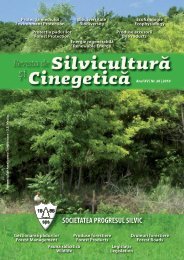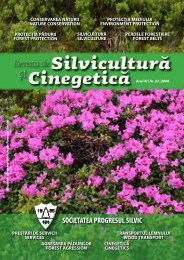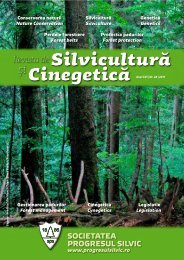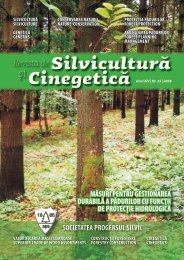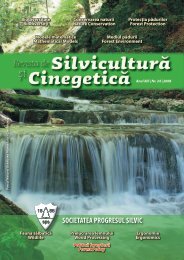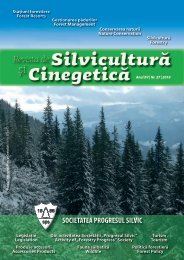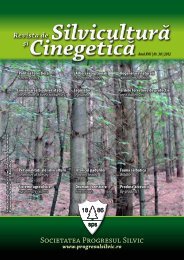Silviculture and Cinegetics Review - Societatea Progresul Silvic
Silviculture and Cinegetics Review - Societatea Progresul Silvic
Silviculture and Cinegetics Review - Societatea Progresul Silvic
Create successful ePaper yourself
Turn your PDF publications into a flip-book with our unique Google optimized e-Paper software.
FORESTRY BELTS SILVICULTURE AND CINEGETIC REVIEW XVII/30/2012<br />
Principles of creating the communication ways protection forest belts<br />
<strong>and</strong> their implementation in the current design practice<br />
1. Introduction<br />
Ilie Muşat<br />
The communication ways protection forest belts (we<br />
will call them hereinafter snow protection forest belts)<br />
form a separate chapter in the domain of protection<br />
forest belts.<br />
Their main characteristic is the great economic role<br />
which they play, they have to ensure unimpeded<br />
movement of vehicles, whether road or rail, heavy<br />
snow falls involving enormous expenditures for<br />
removing their consequences, consequences that may<br />
include even loss of lives. Hence the clear<br />
implications that lies in the appropriate design of this<br />
type of belts.<br />
In terms of weather, in a paper of 2006 I stated that<br />
heavy snow falls the most powerful <strong>and</strong> most<br />
frequently occur in the case of the combination of<br />
height the so called blizzards, when the snow<br />
transport takes place during its falling, with blizzards<br />
when it surface does not snows but, at wind speeds<br />
exceeding 4 m/s (the phenomenon reaches maximum<br />
intensity at speeds of 6-7 m/s), the already fallen snow<br />
is engaged <strong>and</strong> moved to the surface. Note that the<br />
involvement of the already fallen snow can occur even<br />
in clear but dry weather. Accumulation takes place in<br />
compact layers with high specific gravity. Once an<br />
obstacle is met deposit as drifts occurs. Their shape is<br />
characterized by asymmetry of slopes, more steep in<br />
the lee of the obstacle, the slope being more<br />
pronounced the more the obstacle, in our case the<br />
forest belt, will be wider.<br />
Between the width of the forest belt <strong>and</strong> the amount of<br />
snow retained there is, as expected, a close<br />
connection. Thus, if at a forest belt width of 30 m<br />
there is a deposit of up to 50 m 3 of snow at linear<br />
meter length, at a blizzard of the same strength, a<br />
forest belt of 70 m wide holds over 300 m 3 /m.<br />
Therefore for the design it is necessary to know, first,<br />
the amount of snow that can accumulate on the<br />
section of the studied passageway. For this, the<br />
authorities of our country that manage the various<br />
types of roads have maps of heavy snow falls on those<br />
roads.<br />
It should be noted, however that is not considered<br />
justified taking into account as an element of<br />
assessment of the width of the forest belt the<br />
maximum possible height of drifts. Such a solution<br />
would lead to production of large-scale snow breaks<br />
inside of the forest belt. To reduce, perhaps avoid this<br />
danger, it is recommended to consider the so-called<br />
"working height" regarded as being the one that does<br />
not lead to snow breaks within the forest belt.<br />
Research has concluded that the most intense snow<br />
breaks occur at a height over 3 m of the drifts at the<br />
age of 8-10 years of the of the forest belt.<br />
I.Z. Lupe considers necessary to be taken into account<br />
the elements of wind, namely his strength <strong>and</strong> speed.<br />
Another element that must necessarily be taken into<br />
account is the transverse profile of the passageway.<br />
From this point of view, various authors (Bodrov<br />
V.A., Sus N.I.) distinguish three categories of<br />
snowcapped routes:<br />
I - cuttings with a depth of 0.4 to 8.5 m, railway<br />
stations, l<strong>and</strong> with quota 0 compared to the<br />
passageway, but located on plateaus.<br />
II - cuttings with depth below 0.4 m <strong>and</strong> l<strong>and</strong> with<br />
quota 0.<br />
III - embankments with heights below 1.0 m <strong>and</strong><br />
highl<strong>and</strong> areas with height up to 1.0 m.<br />
Other categories of l<strong>and</strong> can be considered not<br />
snowcapped. We must draw attention that currently<br />
there are many roads that have on the edge shrub <strong>and</strong><br />
even tree vegetation, which changes the profile of the<br />
passageway <strong>and</strong> can build snow. It should also be<br />
considered the depth of the fallen snow that is evenly<br />
accumulated in the area <strong>and</strong> that changes the<br />
difference in level between the passageway’s platform<br />
<strong>and</strong> the neighboring l<strong>and</strong>.<br />
2. Width of snow protection forest belts<br />
The lack of special research in our country (though<br />
belts snow protection forests were planted in 1914-<br />
1916 <strong>and</strong> then again after the World War I); require<br />
the use of the same data of the mentioned foreign<br />
authors. According to our theme the width of the<br />
forest belt is determined by the ratio between the<br />
recorded maximum transverse surface of the drifts in<br />
30



